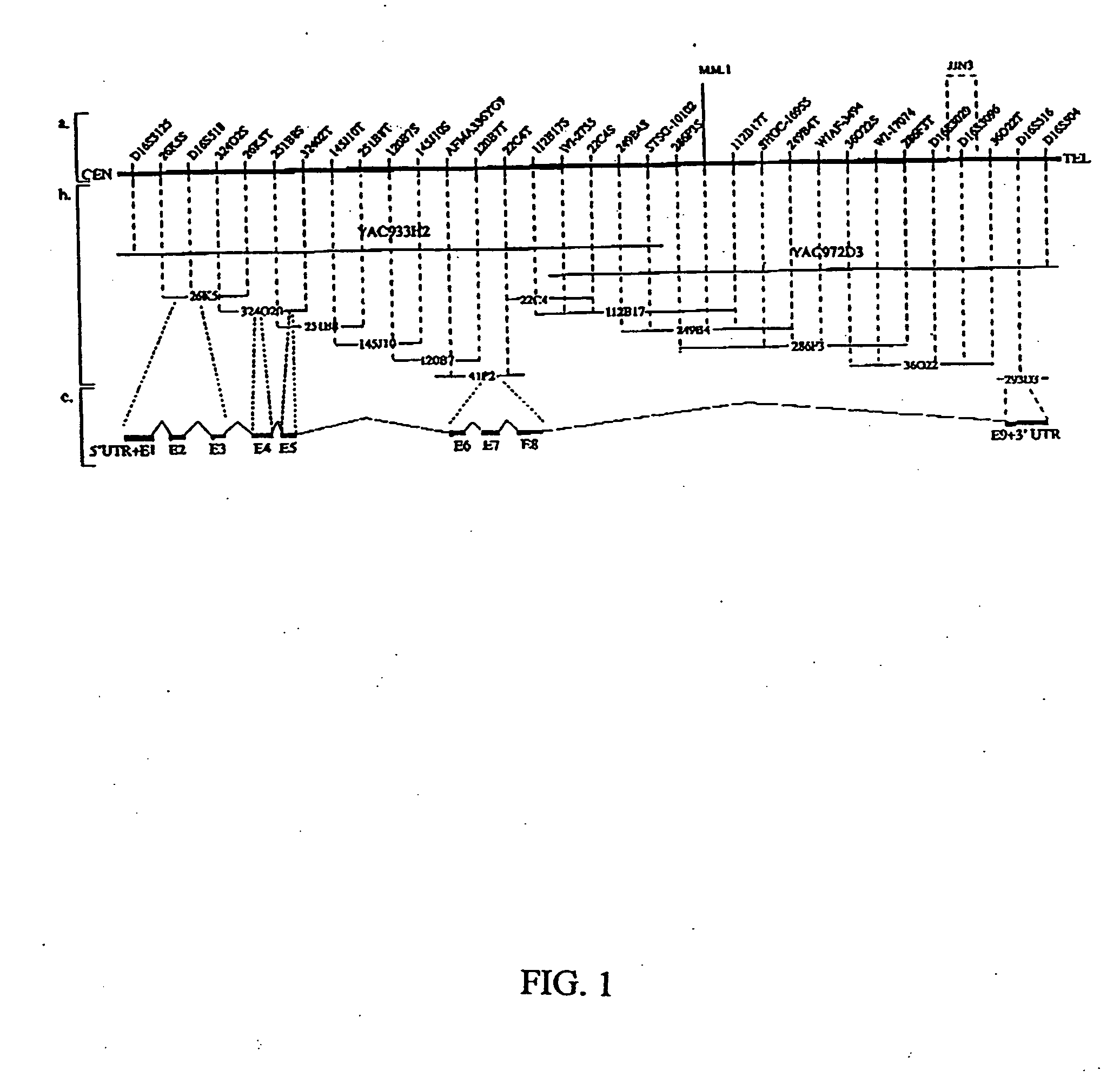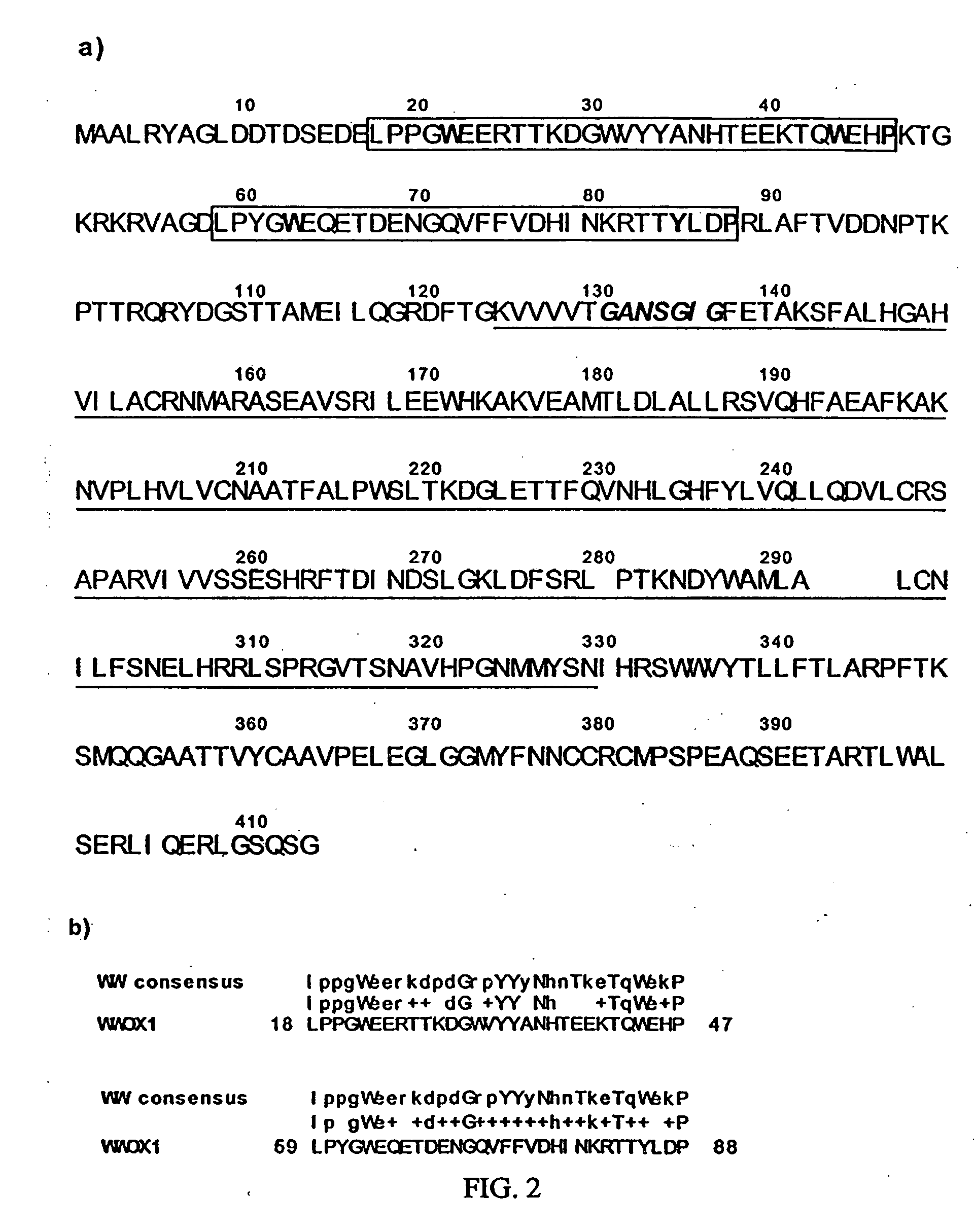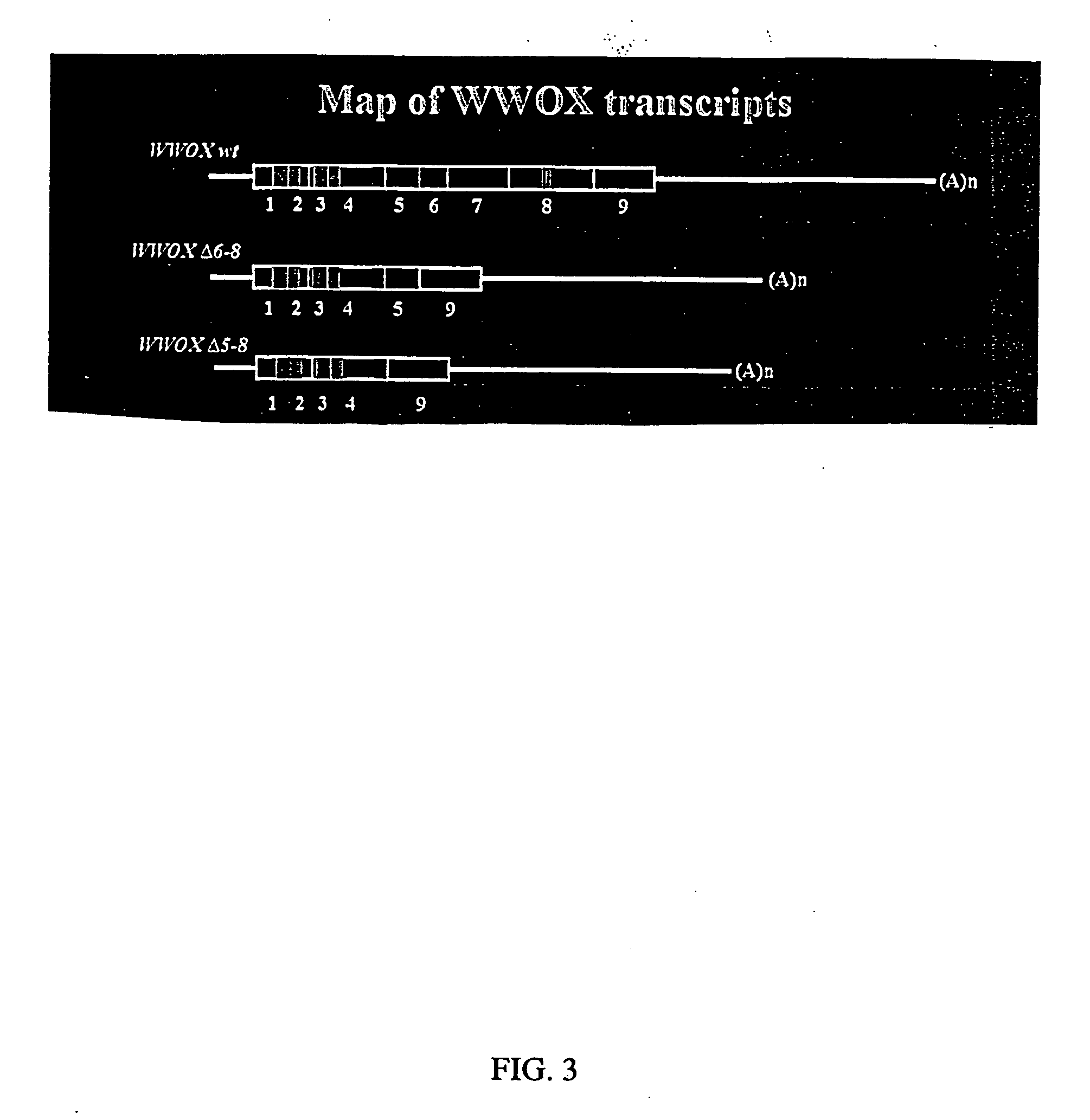Wwox: a tumor suppressor gene mutated in multiple cancers
a tumor suppressor gene and gene technology, applied in the field of molecular biology, oncology and gene therapy, can solve the problems of affecting the growth of cancer cells, affecting the diagnosis and treatment of many common cancer types, and few effective options for many common cancer types
- Summary
- Abstract
- Description
- Claims
- Application Information
AI Technical Summary
Benefits of technology
Problems solved by technology
Method used
Image
Examples
example 1
Isolation and Cloning of WWOX
[0461] Chromosomal and genomic abnormalities affecting chromosome 16q (ch 16q), have been reported in cytogenetic and allelotypic studies of various epithelial tumors. The loss of heterozygosity (LOH), affecting the long arm of this autosome is often observed in breast carcinomas and pre-invasive breast lesions (Sato et al., 1990; Tsuda et al., 1994; Cleton-Jansen et al., 1994; Aldaz et al., 1995; Chen et al., 1996). Other tumor types, such as prostate and hepatic carcinomas also exhibit similar abnormalities (Chen et al., 1996; Carter et al., 1990). Therefore, identification of putative tumor suppressor gene(s) that may reside in the distal portion of ch 16q has been the subject of several studies (Whitmore et al., 1998; Crawford et al., 1999 Savino et al., 1999).
[0462] One of the most commonly affected areas spans the region between STS markers D16S515 and D16S504 with the most affected locus D16S518 at 16q23.3-24.1 (Chen et al., 1996). The high inci...
example 2
Identification of Abnormal Transcripts
[0504] Abnormal WWOX transcripts, such as the alternatively or abnormally spliced versions of WWOX, are identified using cDNA samples synthesized from RNA isolated from tumor samples by means of RT-PCR and employing deletion specific primers.
[0505] In one embodiment, a common 5′ primer 5′-AGGCAGTGCGCAGGCGTGAGC-3′ (SEQ ID NO:14) was used in conjunction with 3′ specific primers spanning the new exon-exon junctions found only in these alternatively spliced forms expressed in tumors:
[0506] The 3′ specific primers used were:
(SEQ ID NO:4)Δ8(5′- ACGGTGGTGGCAGCTCCCTGTTGCGATGG-3′);(SEQ ID NO:5)Δ7-8(5′- ACGGTGGTGGCAGCTCCCTGTTGACATTCTTGG-3′);(SEQ ID NO:6)Δ6-8(5′- ACGGTGGTGGCAGCTCCCTGTTGCCATTCTTC-3′);(SEQ ID NO:7)Δ5-8(5′- ACGGTGGTGGCAGCTCCCTGTTGCTATTCC-3′)(SEQ ID NO:8)Δ4-8(5′- TGGTGGCAGCTCCCTGTTGTCAACAAAAAACAC-3′)(SEQ ID NO:9)Δ3-8(5′- ACGGTGGTGGCAGCTCCCTGTTGCTCC-3′)(SEQ ID NO:3)Δ2-8(5′- ACGGTGGTGGCAGCTCCCTGTTGTTG-3′)
[0507] Using these methods the inve...
example 3
Fluorescent In Situ Hybridization
[0508] Metaphase or Interphase cells from normal or tumor samples were analyzed with probes spanning the WWOX, fragile site 16 D (FRA16D) genomic region. Induction of chromosomal fragility in normal cells such as, peripheral lymphocytes, is achieved by treatment with Aphidicolin (0.4 mM) dissolved in DMSO during the last 26 hrs. of culture. Spontaneous WWOX FRA16D genomic region breakage in tumor cells from diverse origin can also be analyzed.
[0509] Metaphase spreads from normal or tumor cells are prepared after 1 hr. incubation in culture media Colcemid (50 mg / ml). This is followed by standard KCL hypotonic incubation and acid-methanol fixation. Samples from the cells are then spread onto clean glass slides. YAC or BAC probes spanning or flanking the WWOX (FRA16D) genomic region are labeled with digoxigenin or biotin or a fluorescent dye such as FITC or Texas Red and use for in situ hybridization on the cell spreads. Prior to hybridization DNA fro...
PUM
| Property | Measurement | Unit |
|---|---|---|
| diameter | aaaaa | aaaaa |
| wet weight | aaaaa | aaaaa |
| wet weight | aaaaa | aaaaa |
Abstract
Description
Claims
Application Information
 Login to View More
Login to View More - R&D
- Intellectual Property
- Life Sciences
- Materials
- Tech Scout
- Unparalleled Data Quality
- Higher Quality Content
- 60% Fewer Hallucinations
Browse by: Latest US Patents, China's latest patents, Technical Efficacy Thesaurus, Application Domain, Technology Topic, Popular Technical Reports.
© 2025 PatSnap. All rights reserved.Legal|Privacy policy|Modern Slavery Act Transparency Statement|Sitemap|About US| Contact US: help@patsnap.com



